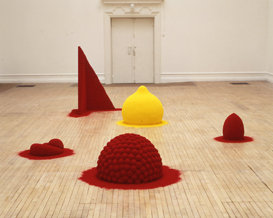Anish Kapoor
dal 17/10/2007 al 19/1/2008
Segnalato da
17/10/2007
Anish Kapoor
Haus der Kunst, Munich
Svayambh. The indian artist creates objects that seem to stem from a different world: sculptures made from powder pigment, monumental installations with the most diverse materials - often sprayed with intense and yet seemingly soft colours. For his exhibition Kapoor has created an enormous, blood-red sculpture that glides almost imperceptibly on tracks through the monumental spaces of the haus der kunst.

Svayambh
The London-based artist Anish Kapoor will create a new work specially for
Haus der Kunst as part of his first comprehensive solo-exhibition in Germany
since showing 1991 at the Kunstverein Hannover and 1996/1997 at the
Kunst-Station Sankt Peter in Cologne. Anish Kapoor has created a new work
specially for Haus der Kunst and in response to its monumental architecture.
The title of this piece and of the exhibition relates back to the Sanskrit
"Svayambhu(v)" meaning self-generated or auto generated.
"Svayambh" is a deep red, wax-like block that will be moving almost
imperceptibly along a set of tracks, which reach from one end of the entire
eastern galleries to the other. Its appearance which is reminiscent of a
train can be related back to Kapoor's fascination with Andrei Konchalovsky's
film "Runaway Train" (1985), where two escaped convicts and a female railway
worker find themselves trapped on a train with no brakes and nobody driving.
Creating a red line through the building, "Svayambh" passes through two
doorways, which form and seemingly force the block through their restrictive
frames making it leave behind smeary traces of its material: a mixture of
Vaseline, paint and wax. This enormous red mass reminiscent of compacted
blood evokes an almost apocalyptic image. Interestingly a red heifer or
"parah adumah" – notably adom means red and dam means blood in Hebrew – is
often associated with the Apocalypse in Judaism. "Svayambh" can be seen in
direct correlation to a further site-specific work, a "wound" or slit of
about 1.5 m that Kapoor will carve directly into a wall. Images such as
these carry even greater connotations in a building with such a difficult
history as the Haus der Kunst's.
There has always been a tension in Kapoor's work between the complexity of
the eye's perception and the roughness of the body, the organ's inner life,
as well as between the made and the unmade, between roughness and
refinement, all of which are forces of nature. In Kapoor's work materiality
is of the essence, though always in connection with a notion of presence and
spirituality that go beyond the objects' superficial "matter of factness".
"Material somehow always leads on to something immaterial" as Kapoor has put
it. He sees this as a fundamental contradictory yet complimentary condition
of the material world. These dialogic contrasts become particularly apparent
in Kapoor's public sculptures over the recent years. Despite their often
monumental proportions, a sense of atmospheric sensuality and even sexuality
is evoked through organic shapes and spheres.
Such biomorphic formations are increasingly found in contemporary
architecture and Kapoor himself has been involved in several architectural
projects – "Descent into Limbo" for documenta IX in 1992 being one of the
earliest examples. He recently completed a project for a subway station in
Naples with the architect collective Future Systems and his collaboration
with structural engineer and writer Cecil Balmond on the awe-inspiring
"Marsyas" for Tate Modern's Turbine Hall is well known.
The show gives an extensive overview of Kapoor's œuvre including also early
works such as "1000 Names" created between 1979 and 1981, a group of
floor-based objects that are covered in pigment of either red, yellow or
white as well as more recent works. "Yellow" (1999), for instance, threatens
to engulf the visitor with its large-scale concave yellow wall. Even newer
works are "S-Curve" (2006), a 10 x 2.5 m polished steel work that through
its undulating s-shape reflects the viewer several times over, and "C-Curve"
(2007) that mirrors but also bends the reflected images of the beholder and
their surroundings. Both appear to be almost cinematic, giving the
impression of being in a film. Most recently Kapoor has been working on a
series of mirrored as well as opaque spheres in various colours that are
fixed to the wall at different heights.
Furthermore, Anish Kapoor will be producing a limited edition with Edition
Schellmann. More details are to follow.
A publication on Anish Kapoor published by Prestel Verlag with an essay by
Rainer Crone, will appear shortly after the opening of this exhibition; 128
pages, in English only, with colour illustrations including the works
especially realized for and in the Haus der Kunst; 39.95 Euro.
The work "Svayambh" was realized in collaboration with the Musée des
Beaux-Arts de Nantes.
Made possible with the support of the friends of Haus der Kunst,
Gesellschaft der Freunde der Stiftung Haus der Kunst e.V.
Haus der Kunst
Prinzregentenstrasse 1 - Munich



